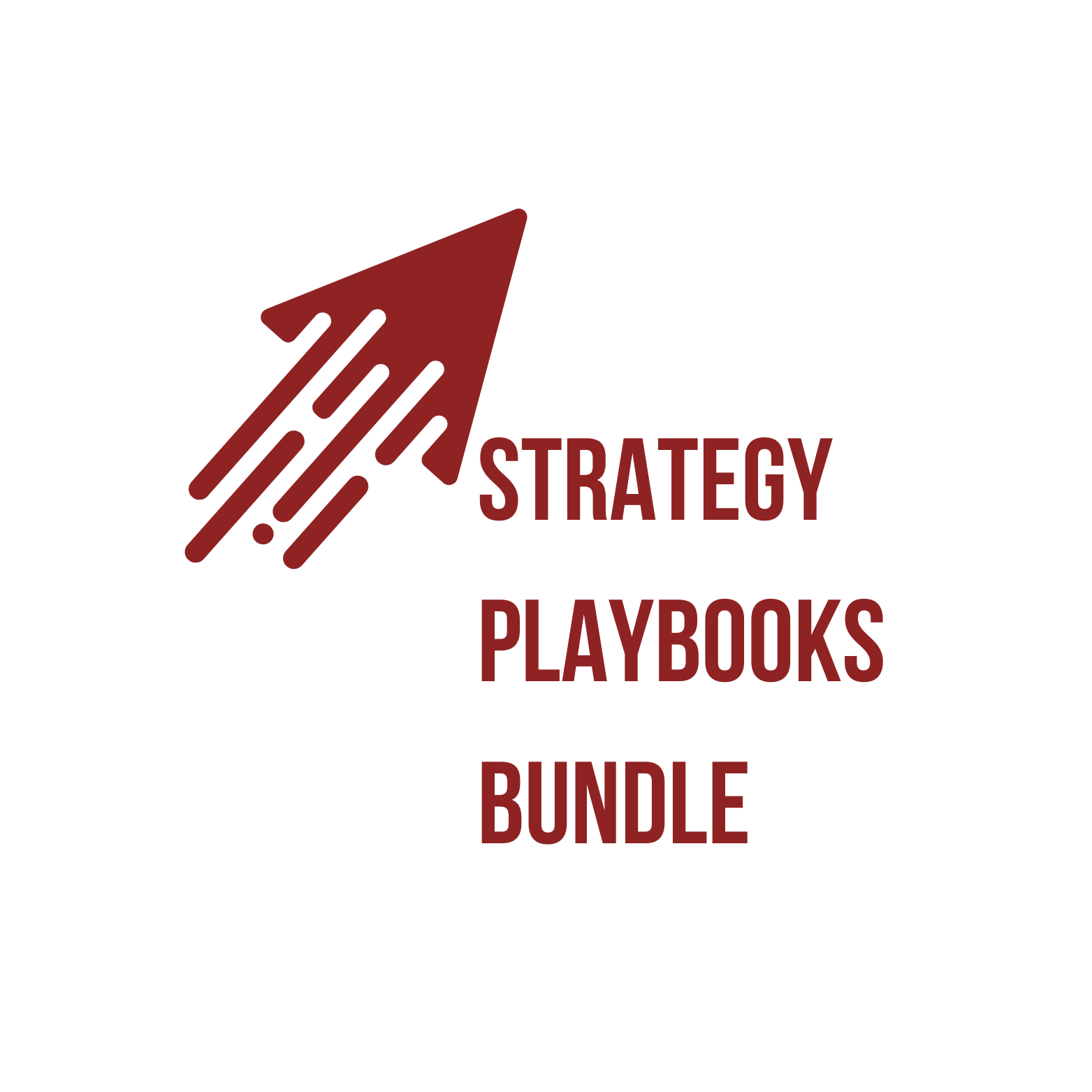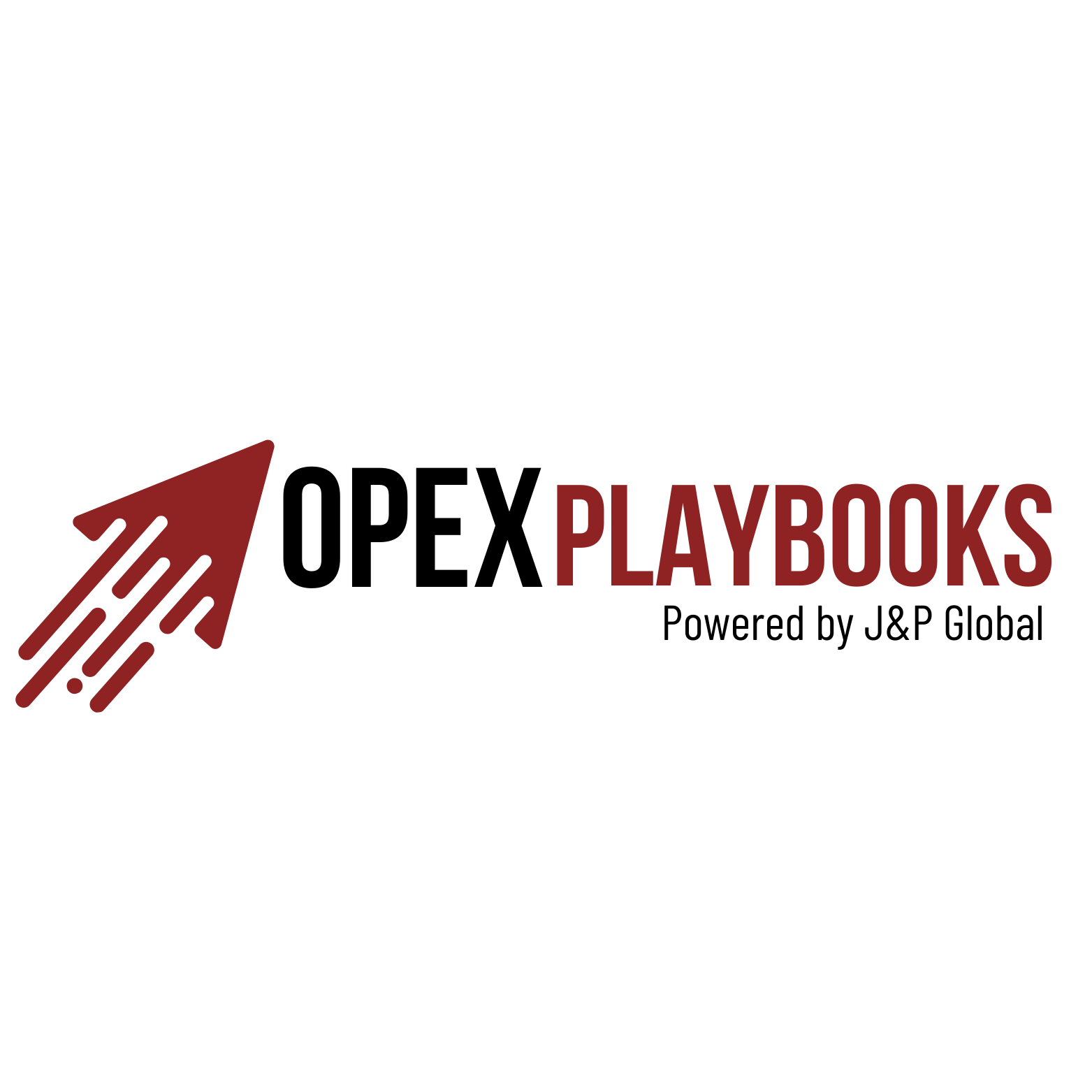STRATEGY
Strategy is not just about big ideas—it’s about creating clarity, alignment, and execution across the organization. Many companies craft ambitious visions but struggle to translate them into measurable results. The Strategy Excellence Playbooks Pack gives you a structured way to close that gap, turning strategy from theory into a living system of action and review.
This pack covers the full spectrum of strategic needs: from Strategy Deployment (Hoshin Kanri), Balanced Scorecard, and OKRs, to Scenario Planning, Business Model Reinvention, Digital Transformation, and Global Market Entry. Each Playbook provides a step-by-step framework, complete with checklists and tools to ensure strategies are aligned, measurable, and sustainable.
Whether you’re shaping a startup’s growth path, guiding a corporate expansion, or building resilience through risk management, these Playbooks help you set direction, mobilize teams, and sustain long-term value creation.
With this pack, strategy becomes practical, executable, and resilient—helping leaders not only decide where to go but also ensure the entire organization moves there together.
STRUCTURE OF A PLAYBOOK
Part 1 – Problem Statement
Part 2 – Framework & Core Concepts
Part 3 – Step-by-Step Guide
Part 4 – Templates & Checklists
Part 5 – Exercises
Part 6 – Roadmap
Part 7 – Action Steps Summary
Part 8 – Conclusion + Call to Action
We have:
1. Strategy Deployment (Hoshin Kanri) Playbook
2. Balanced Scorecard Playbook
3. OKRs Playbook for SMEs
4. Scenario Planning Playbook
5. Strategy Execution Gap Playbook
6. Strategic Alignment Playbook
7. Business Model Reinvention Playbook
8. Digital Transformation Strategy Playbook
9. Sustainability Strategy Playbook
10. Corporate Growth & Expansion Strategy Playbook
11. Competitive Positioning Playbook
12. Vision–Mission–Values Playbook
13. M&A Strategy Playbook
14. Go-to-Market Strategy Playbook
15. Diversification Strategy Playbook
16. Blue Ocean Strategy Playbook
17. Global Market Entry Strategy Playbook
18. Exit Strategy Playbook
19. Long-Term Value Creation Playbook
20. Strategic Risk & Resilience Playbook
21. Strategic Planning Playbook
Contact Us For More Information!
Thank you.
STRATEGY PLAYBOOKS BUNDLE
Focus, alignment, and resilience are the new essentials for strategy. Without them, organizations drift — chasing short-term wins, missing opportunities, and failing to adapt when disruption hits.
The Strategy Playbooks Bundle was built to change that. With structured playbooks, it gives leaders, managers, and teams a complete toolkit to design bold strategies, align execution, and sustain growth.
Created for SMEs, corporates, and scaling organizations, this bundle goes beyond theory. Each playbook combines proven strategy frameworks with OPEX tools, templates, and step-by-step guides that can be applied immediately — from Hoshin Kanri and OKRs to Scenario Planning, Business Model Reinvention, and Strategic Risk & Resilience.
With this bundle, you’ll be able to sharpen vision and values, close execution gaps, reinvent business models, lead digital transformation, and build long-term value creation systems that balance growth with resilience.
The Strategy Playbooks Bundle is more than a set of guides — it’s a complete strategy operating system that helps organizations think clearer, move faster, and execute smarter in any market environment.

469 USD

1. STRATEGY DEPLOYMENT
(HOSHIN KANRI) PLAYBOOK
29 USD
This playbook introduces a Strategy Deployment (Hoshin Kanri) framework that helps organizations translate their long-term vision into a focused set of breakthrough objectives and cascade them into daily management routines. Unlike generic planning guidance, this playbook provides a disciplined, OPEX-driven approach that connects high-level ambition with execution on the ground, ensuring that strategy is not just written but lived across the organization.
Aligns strategy with operations – using structured tools such as the Hoshin X-Matrix, Catchball dialogues, KPI Trees, and Bowling Charts to break down enterprise-wide goals into departmental, team, and individual targets. This structured alignment ensures that everyone — from executives to frontline teams — knows how their work contributes to strategic success.
. Focuses on customer value – ensuring that every objective contributes to improving quality, delivery, cost efficiency, and customer experience. By embedding Lean thinking, organizations eliminate waste and reduce process variation, making sure that resources are allocated to what matters most for customers.
. Bridges the gap between “plan” and “do” – embedding PDCA (Plan–Do–Check–Act) cycles, A3 problem-solving, and tiered visual management into review processes. Monthly, weekly, and even daily reviews create fast feedback loops that allow organizations to correct course quickly and maintain execution discipline.
. Simplifies execution – limiting the number of strategic priorities to avoid dilution of effort, clarifying ownership and accountability, and linking initiatives to measurable outcomes. Standardized dashboards and review calendars make progress visible, ensuring leaders can monitor performance at a glance and teams can stay focused on what matters most.
Organizations applying this framework often achieve:
. A unified sense of direction (“True North”), with clear and visible linkage from leadership intent to frontline actions.
. Stronger cross-functional alignment, with fewer conflicting priorities and better collaboration between departments.
. Faster issue escalation and resolution through structured tiered huddles, visual dashboards, and A3 reports that bring transparency to challenges.
. Higher success rates in achieving annual and quarterly targets, sustained by the continuous improvement discipline of PDCA cycles.
By embedding Strategy Deployment (Hoshin Kanri) into the management system, organizations move from fragmented planning to an integrated operating model that balances vision with execution, short-term performance with long-term transformation, and leadership intent with customer value.

2. BALANCED SCORECARD PLAYBOOK
29 USD
This playbook reframes the Balanced Scorecard as a management system for execution, not a reporting template. It adapts Kaplan & Norton’s original four perspectives—Financial, Customer, Internal Processes, and Learning & Growth—and integrates them with OPEX discipline to ensure that measures are tied directly to strategy deployment, continuous improvement, and decision-making routines.
Unlike traditional KPI dashboards, this playbook frames the Balanced Scorecard as a management system built for alignment and learning:
. Balanced perspectives – combining both lagging indicators (financial outcomes) and leading drivers (customer, process, learning) to provide a fuller view of performance.
. Direct operational link – each metric is connected to strategy maps, value streams, and improvement initiatives, preventing KPIs from becoming isolated numbers.
. Action-driven use – deviations are not just noted; they trigger structured responses through PDCA cycles, A3 analysis, or governance reviews.
. Cascaded accountability – objectives are translated from enterprise vision into departmental and individual scorecards, reinforced by RACI clarity.
. Adaptive design – the scorecard is reviewed and updated as conditions change, making it a living system rather than a static report.
Observed Outcomes in Practice In organizations where the Balanced Scorecard is applied as a living management system rather than a reporting tool, recurring outcomes have been documented, such as:
. Stronger strategic alignment – employees can trace their KPIs back to enterprise-level goals, reducing misaligned effort.
. Earlier detection of risks and opportunities – leading indicators (e.g., customer satisfaction, process cycle time) give advance warning before financial impact occurs.
. Better resource allocation – scorecards highlight which initiatives create value, helping leaders prioritize and avoid duplication.
. Clear accountability – each metric has an assigned owner, with structured review cycles that reinforce responsibility.
. Cultural shifts toward evidence-based management – decision-making becomes less opinion-driven and more grounded in data that spans financial and non-financial dimensions.
These outcomes are not promises but patterns consistently observed in organizations that apply the Balanced Scorecard with OPEX discipline.

3. OKRS PLAYBOOK FOR SMES
29 USD
This playbook introduces Objectives and Key Results (OKRs) as a practical framework for SMEs. OKRs combine direction (Objectives) with measurement (Key Results), creating a bridge between strategy and execution.
What makes this playbook distinct is not just OKRs themselves, but their integration with OPEX principles:
. Clarity and focus – OKRs are designed to narrow attention to a few high-impact objectives, making progress visible.
. Alignment – Objectives cascade naturally across teams, supported by RACI and governance routines, without adding bureaucracy.
. Adaptability – By using quarterly cycles and mid-course reviews, OKRs create a rhythm of planning and learning rather than fixed annual commitments.
. Measurable discipline – Every Key Result is numeric, time-bound, and tied to outcomes instead of activities, reinforcing accountability.
. Link to OPEX tools – OKRs can be embedded into PDCA cycles, Lean visual boards, and KPI dashboards, ensuring that improvement work connects directly to strategy.
This is not a promise of automatic growth—it is a framework for disciplined goal management. The playbook gives SMEs a structured way to translate strategy into action, while leaving room for continuous improvement and learning.

4. SCENARIO PLANNING PLAYBOOK
29 USD
This playbook introduces a Scenario Planning Framework tailored for SMEs, built on the foundation of Operational Excellence (OPEX) principles. In today’s volatile markets, traditional planning approaches that rely on a single forecast or linear projection often leave organizations exposed to shocks and surprises. Scenario planning, by contrast, creates a structured set of plausible futures, enabling leaders to stress-test strategies, allocate resources more effectively, and build resilience against uncertainty.
Unlike abstract scenario exercises that remain theoretical, this playbook emphasizes practical application and operational linkage, ensuring that scenarios inform not just strategy, but also day-to-day decision-making and measurable performance outcomes.
Key features of this playbook include:
. Structured foresight – a step-by-step method for identifying key drivers of change, mapping critical uncertainties, and constructing multiple future scenarios that reflect both risks and opportunities.
. Operational linkage – connecting scenarios directly to strategic choices, KPIs, resource allocation, and execution plans, ensuring that scenario work translates into actionable decisions rather than abstract storytelling.
. Risk and opportunity framing – helping leaders evaluate not only potential threats (e.g., supply chain disruptions, regulatory shifts, technological change) but also growth opportunities that may emerge under different conditions.
. Continuous improvement cycle – treating scenario planning as a living process, regularly updated with new market signals, data insights, and stakeholder feedback. This ensures the framework remains relevant as environments evolve.
By using this playbook, organizations can move beyond rigid annual planning and instead embed a culture of flexibility, adaptability, and strategic resilience. This ensures that strategy is not only visionary but also measurable in execution, capable of withstanding disruption while seizing emerging opportunities.

5. STRATEGY EXECUTION GAP PLAYBOOK
29 USD
This playbook introduces a Strategy Execution Gap Framework, designed to help organizations close the distance between strategic intent and operational outcomes. Many strategies fail not because they are poorly designed, but because they never make the leap from high-level goals to daily execution. This playbook bridges that divide by combining practical tools, governance discipline, and adaptability.
This playbook emphasizes:
. Translation of strategy into operations – cascading enterprise goals into measurable KPIs, projects, and frontline tasks using OPEX tools such as Hoshin Kanri, Balanced Scorecards, and KPI dashboards, ensuring strategy is embedded into daily workflows.
. Alignment and focus – preventing initiative overload and siloed projects by ensuring every initiative directly contributes to customer value, operational efficiency, and long-term objectives, not just departmental interests.
. Governance and accountability – embedding execution discipline through daily huddles, structured reviews, and PDCA cycles, so leaders and teams can track progress, resolve issues quickly, and sustain momentum.
. Practical adaptability – creating clear priorities, structured feedback loops, and decision frameworks that allow leaders to pivot when market conditions, customer needs, or internal capabilities shift.
This playbook helps organizations build a living system—reviewed frequently, measured rigorously, and adapted continuously to remain relevant and effective.

6. STRATEGIC ALIGNMENT PLAYBOOK
29 USD
This playbook introduces a Strategic Alignment Framework that ensures every part of the organization — from the boardroom to the front line — is working toward the same set of goals. Most organizations fail not because they lack vision, but because priorities get lost in translation as they cascade through layers of management. This playbook provides a practical system to connect intent with execution and keep alignment alive across time.
Unlike generic strategy manuals, this playbook focuses on:
. End-to-end linkage – creating a clear thread from vision and mission → corporate priorities → departmental objectives → team KPIs. This ensures that every employee can see how their daily work contributes to long-term success.
. Practical OPEX tools – applying proven methods such as Hoshin Kanri, Balanced Scorecards, and alignment maps to create full traceability. This removes ambiguity and provides a shared language for measuring progress.
. Cross-functional clarity – breaking down silos by aligning initiatives across functions, not just within departments. When marketing, operations, HR, and finance are aligned to the same priorities, execution is faster and more effective.
. Governance discipline – embedding routines of check, review, and reinforcement at every level. Alignment is maintained through daily huddles, monthly KPI reviews, and quarterly strategy refreshes, ensuring strategy doesn’t drift over time.
. Adaptability – recognizing that alignment is not static. Market changes, customer needs, and organizational shifts require ongoing recalibration. This playbook builds in feedback loops so alignment evolves with context while staying true to the organization’s core mission.
This playbook makes it a living, connected system — one that ensures clarity, consistency, and collective focus across the entire organization.

7. BUSINESS MODEL REINVENTION PLAYBOOK
29 USD
Business models are under unprecedented pressure. Shifts in technology, customer expectations, regulatory landscapes, and competitive intensity demand that organizations continuously reassess how they create, deliver, and capture value. Traditional innovation approaches often focus on incremental product changes or isolated cost optimizations, but they fall short when the core business model itself needs reinvention.
This playbook introduces a Business Model Reinvention Framework designed to help leaders move beyond ad-hoc innovation efforts and adopt a structured, disciplined approach to transformation. It equips executives, strategists, and operational leaders with practical tools to evaluate current business models, design future-ready alternatives, and execute reinvention in a way that is both sustainable and scalable.
This playbook emphasizes five distinctive pillars:
. Systematic Diagnosis — A rigorous assessment of strengths and weaknesses across revenue streams, cost structures, customer channels, and value delivery mechanisms. This ensures reinvention begins with clarity about where the current model is breaking down.
. Customer-Centric Design — Reinvention is anchored in customer needs, using Voice of Customer (VoC), Value Proposition Canvas, and journey-mapping techniques to ensure relevance and differentiation.
. OPEX Integration — Lean principles are embedded throughout the reinvention process to eliminate waste, streamline workflows, and ensure that new models are not only innovative but also feasible, efficient, and scalable in practice.
. Experimentation Discipline — Reinvention requires testing and validation, not guesswork. This playbook stresses the importance of pilots, scenario planning, and minimum viable business models (MVBMs) as controlled experiments before committing large-scale resources.
. Scalable Transformation — Reinvention does not stop at design. The framework links business model innovations to corporate strategy, KPIs, and governance routines to ensure execution, accountability, and long-term impact.
This playbook acts as both a diagnostic lens and a practical roadmap. It provides leaders with clarity on when and how to reinvent, reduces risk by embedding experimentation and OPEX principles, and accelerates execution by linking initiatives directly to strategy and performance metrics. It is designed for organizations that want to remain relevant, competitive, and profitable in an environment where business-as-usual is no longer an option.

8. DIGITAL TRANSFORMATION STRATEGY PLAYBOOK
29 USD
Technology-driven business environment, digital transformation has moved from being an option to becoming a necessity. Yet many organizations still struggle to translate digital ambitions into meaningful, scalable outcomes. Too often, digital efforts remain fragmented — confined to isolated pilot projects, new software deployments, or IT upgrades that fail to deliver enterprise-wide impact. These fragmented initiatives may improve efficiency locally, but they rarely transform how the business creates value, competes, and grows.
This playbook introduces a Digital Transformation Strategy Framework that provides leaders with structured tools to move beyond one-off projects and instead design a roadmap for holistic transformation. It equips executives and managers with a clear approach to evaluate current capabilities, prioritize investments, and integrate digital initiatives into the broader business strategy.
Unlike generic IT modernization guides, this playbook emphasizes five critical pillars that determine long-term success:
. Alignment with Strategy — Every digital initiative must tie directly to the organization’s vision, mission, and measurable business outcomes. Transformation is not about adopting the newest technologies; it is about using technology as a lever to achieve strategic goals.
. Customer Value Creation — Digital transformation must enhance the customer journey, elevate experiences, and create new sources of value. Efficiency gains are important, but the ultimate measure of success is whether digital enables the business to serve customers better, faster, and more effectively.
. Integration with OPEX Tools — Digital capabilities achieve maximum impact when combined with Operational Excellence disciplines such as Lean, Six Sigma, and continuous improvement. This ensures that transformation not only innovates but also eliminates waste, reduces variation, and drives sustainable scalability.
. Governance and Execution Discipline — Successful transformation requires more than vision; it requires execution. This framework embeds clear ownership, KPIs, accountability structures, and review cadences, ensuring that digital initiatives are managed with the same rigor as financial or operational priorities.
. Adaptability — Transformation is not a one-off milestone but an ongoing journey. Technology, markets, and customer expectations evolve constantly, requiring organizations to build adaptive capacity, experiment continuously, and recalibrate strategies as conditions change.
This playbook provides both structure and agility: structure in the form of frameworks, governance, and OPEX integration; agility in the form of customer-centric design, experimentation, and continuous improvement. It is designed for leaders who want to ensure their digital investments go beyond isolated wins and instead drive sustainable, enterprise-wide transformation that strengthens competitiveness and long-term value creation.

9. SUSTAINABILITY STRATEGY PLAYBOOK
29 USD
This playbook introduces a Sustainability Strategy Framework designed to help organizations embed ESG (Environmental, Social, and Governance) into the heart of operations and long-term strategy. It goes beyond generic CSR guidelines, offering a structured approach to ensure that sustainability is not an add-on, but a driver of growth, efficiency, resilience, and stakeholder trust.
. Integration with business performance – Embedding sustainability into the core value chain, ensuring that ESG initiatives support revenue growth, cost efficiency, risk management, and innovation. The framework helps leaders demonstrate that sustainable practices are not a trade-off but a catalyst for competitive advantage.
. Clear translation to operations – Moving from abstract commitments to practical execution by cascading ESG goals into KPIs, departmental objectives, and daily practices. This ensures sustainability is visible and actionable at every organizational level, from boardroom targets to frontline routines.
. Governance and accountability – Defining clear ownership structures with RACI roles, establishing regular review cadences, and setting up escalation paths for underperformance. This creates the discipline needed to ensure sustainability commitments are met consistently.
. Practical tools – Equipping teams with templates, checklists, dashboards, and reporting frameworks that make ESG measurable, trackable, and transparent. By combining ambition with execution tools, organizations avoid “greenwashing” and deliver tangible impact.
. Continuous improvement – Treating sustainability as a living system, regularly reviewed and refined through PDCA cycles, Kaizen workshops, and benchmarking against global standards. This ensures the organization adapts as regulations tighten, stakeholder expectations evolve, and new risks emerge.
This playbook helps leaders embed it as a core operating system for value creation, resilience, and long-term stakeholder trust. By doing so, organizations not only comply with ESG requirements but also build a stronger brand, attract top talent, and unlock new growth opportunities in an era where sustainability is inseparable from business excellence.

10. CORPORATE GROWTH & EXPANSION STRATEGY PLAYBOOK
29 USD
This playbook introduces a Corporate Growth & Expansion Strategy Framework, designed to help organizations systematically identify, prioritize, and execute growth opportunities while ensuring full alignment with long-term strategic goals. It provides leaders with a disciplined roadmap that connects ambition to execution, enabling sustainable performance rather than opportunistic expansion. Unlike generic growth guides, this playbook emphasizes the integration of strategy, governance, customer value, and operational excellence to build growth that lasts.
. Structured growth pathways – balancing different approaches such as organic growth (new markets, new products, internal innovation), partnerships & alliances (joint ventures, strategic collaborations, distribution partnerships), and acquisitions & M&A. The framework guides organizations in assessing which pathway is most appropriate based on capability, risk, and strategic fit.
. Customer-centric expansion – anchoring growth decisions in customer value, satisfaction, and experience. Expansion is designed to improve quality, accessibility, affordability, or differentiation, ensuring that growth enhances competitiveness rather than diluting focus.
. Data-driven decision-making – leveraging KPIs, growth dashboards, market intelligence, and scenario planning to test assumptions, validate opportunities, and avoid costly missteps. Decisions are grounded in evidence and continuously reviewed against market shifts and performance outcomes.
. Governance and accountability – embedding strong oversight mechanisms, RACI ownership models, risk management frameworks, and feedback loops. This ensures growth is not left to chance or individual interpretation but managed through disciplined governance processes with clear escalation paths.
. Scalability – building repeatable systems, standardized processes, and operational resilience that allow the organization to expand sustainably without overextension. This includes creating robust talent pipelines, digital systems, and supply chain capabilities that can support growth across multiple geographies or business units.
This playbook helps leaders pursue profitable, disciplined, and sustainable expansion. It positions growth not as a gamble, but as a strategic, data-driven process that strengthens competitiveness, unlocks customer value, and secures long-term shareholder and stakeholder trust.

11. COMPETITIVE POSITIONING PLAYBOOK
29 USD
This playbook introduces the Competitive Positioning Framework, designed to help organizations define, test, and sustain a clear and defensible position in the market. It moves beyond abstract strategy statements and provides a structured, evidence-based approach that connects customer needs, competitive intelligence, and operational execution. Unlike generic strategy guides, this playbook emphasizes the disciplined integration of customer insights, data analytics, OPEX tools, and adaptability to ensure positioning is both meaningful and sustainable.
. Customer-centric positioning – anchored in the Voice of Customer (VoC) and real buyer insights rather than internal assumptions. This ensures the organization positions itself around what customers truly value, such as faster service, personalized experiences, or superior reliability, instead of generic claims.
. Data-driven analysis – using competitive benchmarks, market mapping, segmentation models, and performance dashboards to identify where the company stands today and where white-space opportunities exist. Positioning decisions are backed by facts, not intuition, reducing the risk of costly missteps.
. Value-based differentiation – focusing on what customers are willing to pay for, not just what the organization is capable of delivering. This ensures that positioning translates into pricing power, margin protection, and loyalty, moving beyond vague slogans to measurable competitive advantages.
. OPEX integration – linking positioning directly to operational excellence practices such as Lean workflows, Six Sigma quality, visual management, and standardized processes. This ensures that the organization can deliver its promised value consistently, building credibility and trust in the marketplace.
. Adaptability – embedding a cycle of regular reviews, competitor tracking, scenario planning, and customer feedback loops so positioning remains relevant as markets shift. Organizations that adapt quickly protect their competitive edge and avoid becoming irrelevant in fast-changing industries.
The playbook provides organizations with a structured approach to move from generic claims like “we provide quality service” to evidence-backed positioning that resonates deeply with customers and is difficult for competitors to copy, resulting in a defensible market position that drives growth, builds brand equity, and sustains long-term competitive advantage.

12. VISION–MISSION–VALUES PLAYBOOK
29 USD
This playbook introduces a Vision–Mission–Core Values Framework that goes far beyond wordsmithing or poster statements. It is designed to help organizations define, refine, and embed their guiding principles into both culture and operations, turning them into everyday tools for decision-making and execution. Unlike generic vision–mission exercises that often produce vague or aspirational phrases, this playbook emphasizes clarity, alignment, and practical integration so that these principles become true drivers of performance and resilience.
. Clarity and distinctiveness – crafting statements that clearly articulate what makes the organization unique, not generic claims that could belong to any competitor. A well-defined vision, mission, and set of values provide both internal inspiration and external differentiation, serving as a compass for growth and positioning.
. Operational alignment – linking vision and mission directly to strategic priorities, KPIs, and daily management routines. This ensures that guiding principles are not isolated slogans, but integrated into the OPEX system — influencing goal deployment, process design, and performance tracking.
. Behavioral reinforcement – translating values into observable behaviors, supported by leadership role-modeling and peer accountability. Values are reinforced when they are tied to how employees act, collaborate, and serve customers, making culture both visible and measurable.
. Governance and refresh – establishing a cadence for review and renewal, ensuring that vision, mission, and values remain relevant as markets, strategies, and stakeholder expectations evolve. This prevents them from becoming outdated artifacts and keeps them aligned with long-term aspirations.
. Cultural integration – embedding vision, mission, and values into onboarding programs, recognition systems, leadership development, and performance reviews. When tied to people processes, these principles actively shape organizational culture and influence how employees make decisions every day.
The playbook provides organizations with a structured approach to transform vision, mission, and values from aspirational statements into actionable drivers of performance and culture. They evolve into a strategic anchor and cultural compass, aligning leadership intent with frontline execution, shaping decisions at every level, and ensuring that daily actions consistently reinforce long-term goals and organizational purpose.

13. M&A STRATEGY PLAYBOOK
29 USD
The M&A Strategy Playbook provides a structured, step-by-step framework to help organizations pursue mergers, acquisitions, and divestitures with clarity, discipline, and measurable outcomes. Too often, M&A efforts fail to deliver promised value — not because of poor financial logic, but due to weak integration, cultural misalignment, or lack of governance. Unlike generic financial playbooks that focus primarily on valuation and deal structuring, this framework integrates strategy, operations, people, and culture to ensure transactions create sustainable long-term value rather than short-lived wins.
This playbook emphasizes:
. Strategic fit over opportunism – ensuring every deal aligns with corporate growth priorities, market positioning, and core capabilities, rather than chasing short-term opportunities or reactive acquisitions.
. End-to-end discipline – covering the full lifecycle from target identification and screening to due diligence, negotiation, and post-merger integration governance, with clear checkpoints at each stage.
. Balanced due diligence – expanding beyond financial analysis to evaluate culture, operations, customer base, supply chain resilience, and ESG factors, reducing blind spots that often undermine deals.
. Integration planning – embedding synergy capture into KPIs, daily management systems, and governance routines, ensuring benefits are tracked, realized, and sustained.
. Cultural alignment – using core values, leadership behaviors, and change management practices to unify teams, reduce resistance, and foster trust across the merged entity.
The playbook provides leaders with a structured approach to transform M&A from high-risk, one-off transactions into a repeatable growth engine, supported by discipline, transparency, and operational excellence.

14. GO-TO-MARKET STRATEGY PLAYBOOK
29 USD
This playbook introduces a Go-to-Market (GTM) Strategy Framework, designed to help organizations move from ad-hoc product launches to disciplined, scalable GTM systems. Many organizations struggle with inconsistent execution, siloed functions, and unclear accountability, resulting in wasted spend and missed revenue opportunities. This framework provides leaders with a structured, repeatable process for bringing products, services, or solutions to market in a way that delivers predictable outcomes and long-term impact.
Unlike generic launch checklists that focus only on tactical activities, this playbook emphasizes five core principles:
. Strategic alignment – ensuring that positioning, messaging, channel strategy, and pricing models are not developed in isolation but directly tied to business outcomes such as market share growth, revenue acceleration, or customer acquisition. This ensures GTM efforts reinforce the broader corporate strategy.
. Customer value creation – grounding every GTM element in customer jobs-to-be-done, pain/gain mapping, and value proposition design. By putting the customer at the center, organizations avoid pushing products and instead build GTM motions that solve real problems and deliver tangible value.
. Integration with OPEX tools – embedding Lean principles, PDCA cycles, and A3 problem-solving into pipeline and funnel optimization. This helps teams identify bottlenecks, remove waste, and continuously improve conversion rates across the GTM journey.
. Execution discipline – establishing clear GTM governance structures, with defined RACI roles, KPIs, and review cadences across Marketing, Sales, and . Customer Success. By turning GTM into a cross-functional management system, organizations reduce friction, accelerate feedback, and ensure accountability.
. Adaptability – treating GTM as an iterative cycle (test → learn → scale) rather than a one-off launch event. This approach builds agility, allowing organizations to refine their strategy based on customer feedback, market dynamics, and performance data before scaling at full speed.
The playbook provides organizations with a structured approach to move beyond sporadic product pushes and build a repeatable GTM engine that drives revenue growth, customer adoption, and long-term competitiveness.

15. DIVERSIFICATION STRATEGY PLAYBOOK
29 USD
Diversification offers tremendous potential for growth, resilience, and innovation, but it is also one of the riskiest strategies an organization can pursue. Too often, diversification is approached as a gamble—chasing new products, markets, or technologies without structure. The result is wasted investment, diluted focus, and missed opportunities.
This playbook introduces a Diversification Strategy Framework that transforms diversification from a high-risk leap into a disciplined, step-by-step growth process. It provides a practical roadmap to evaluate opportunities, balance risk, and build sustainable expansion.
This playbook emphasizes five critical dimensions:
. Strategic Alignment – every diversification move is tested against the long-term vision, mission, and goals of the organization.
. Risk-Managed Growth – growth initiatives are treated as a portfolio, balancing core extensions, adjacent opportunities, and transformational bets.
. OPEX Integration – Lean, Six Sigma, and continuous improvement ensure diversification strengthens operational excellence rather than undermines it.
. Customer Validation – decisions are grounded in real demand through Voice of Customer, pilots, and feedback loops, not untested assumptions.
. Governance and Discipline – structured reviews, clear KPIs, and phased pilots provide accountability and minimize risks at every stage.
By following this playbook, diversification becomes not just a search for growth but a repeatable and reliable engine—strategic, customer-driven, efficient, and governed with discipline.

16. BLUE OCEAN STRATEGY PLAYBOOK
29 USD
The Blue Ocean Strategy Playbook introduces a structured framework to help organizations systematically shift from competing head-to-head in crowded markets (“red oceans”) to creating new, uncontested market spaces (“blue oceans”). In environments where competition is intense, margins are shrinking, and customer loyalty is fragile, simply trying to outperform rivals is not enough. Organizations need a disciplined approach to innovation that expands demand, reduces cost pressures, and builds sustainable advantage.
Unlike generic innovation guides that rely on brainstorming or incremental improvements, this playbook emphasizes five critical pillars:
. Value Innovation — pursuing differentiation and cost leadership simultaneously, rather than choosing between them. This allows organizations to break the trade-off between value and efficiency, creating offerings that are both unique and affordable.
. Strategic Tools — applying proven methodologies such as the Strategy Canvas (to visualize competitive landscapes) and the Four Actions Framework (Eliminate–Reduce–Raise–Create) to systematically design bold moves, instead of relying on intuition alone.
. Customer-Centric Insights — uncovering non-customers and unmet needs through Voice of Customer (VoC), ethnographic research, and market mapping, generating new sources of demand rather than fighting for a bigger share of existing demand.
. Integration with OPEX — ensuring Blue Ocean moves are scalable and operationally sound by linking them with Lean, Six Sigma, and continuous improvement practices. This prevents “big ideas” from collapsing under execution challenges by embedding efficiency and quality discipline into delivery.
. Execution Discipline — embedding governance structures, KPIs, and review cycles so that Blue Ocean initiatives don’t remain on slides, but become operational realities. Clear ownership, progress tracking, and feedback loops ensure sustainable adoption across the enterprise.
The playbook provides leaders with a structured approach to move beyond incremental competition and unlock new growth horizons that competitors cannot easily replicate. It turns strategic creativity into disciplined execution, enabling organizations to consistently generate profitable, customer-driven innovations while maintaining operational excellence.

17. GLOBAL MARKET ENTRY STRATEGY PLAYBOOK
29 USD
The Global Market Entry Strategy Playbook introduces a structured framework to help organizations design, execute, and sustain international expansion with clarity and discipline. Entering new markets is one of the most powerful growth levers, but it is also one of the riskiest. Many expansions fail due to poor market selection, lack of cultural adaptation, weak governance, or underestimated risks. This playbook provides leaders with a systematic approach that balances opportunity with operational resilience.
This playbook emphasizes:
. Strategic Fit — ensuring global expansion aligns directly with the organization’s vision, mission, and long-term growth objectives, rather than opportunistic or reactive moves. Every market entry must serve the larger corporate narrative.
. Market Selection Discipline — using structured tools, market scoring models, and weighted criteria to evaluate and prioritize countries or regions. This ensures leaders invest in markets with the highest potential and lowest misalignment risk.
. Entry Mode Optimization — guiding organizations in choosing the most suitable mode of entry, whether exporting, licensing, franchising, partnerships, acquisitions, or greenfield investments, based on resources, risk appetite, and local conditions.
. Localization Excellence — adapting products, services, customer experiences, and branding to meet local preferences and cultural expectations. This prevents missteps that can erode trust and ensures that the brand resonates authentically in each market.
. Integration with OPEX — embedding Lean, Six Sigma, governance routines, and PDCA cycles into the global expansion process to ensure efficiency, scalability, and consistency across multiple geographies.
. Risk & Resilience — proactively managing geopolitical, regulatory, cultural, financial, and operational risks. The framework integrates scenario planning, compliance audits, and resilience planning to safeguard against disruptions.
The playbook provides organizations with a structured approach to transform global expansion into a disciplined growth engine, with pathways to unlock revenue opportunities, strengthen competitiveness, and improve resilience across international markets.

18. EXIT STRATEGY PLAYBOOK
29 USD
The Exit Strategy Playbook provides a structured, step-by-step framework to help business owners, leaders, and advisors prepare for and execute a successful exit. Exiting a business is one of the most significant decisions in the lifecycle of an organization, yet many leaders approach it with limited planning, relying only on financial metrics or last-minute succession efforts. This playbook goes beyond generic succession or financial guides by integrating strategic clarity, operational readiness, cultural alignment, and governance discipline to ensure that the exit is not only profitable but also sustainable.
Specifically, this playbook emphasizes:
. Vision-driven outcomes – defining personal, financial, and legacy goals to guide the exit process. Whether the aim is wealth transfer, leadership continuity, or community impact, the exit must serve both the owner’s aspirations and the organization’s future.
. Valuation readiness – aligning financial performance, operational efficiency, and brand equity to maximize business worth. Buyers and investors reward businesses that demonstrate resilience, scalability, and clear value drivers.
. Operational excellence – reducing owner dependence, streamlining core processes, and building systems that create transferable value. This ensures the business continues to thrive beyond the founder or current leadership.
. Exit options analysis – evaluating multiple pathways such as sale, merger, IPO, ESOP, management buyout, or family succession, weighing the trade-offs in control, valuation, and long-term impact.
. Governance and compliance – embedding tax, legal, and regulatory considerations, as well as stakeholder communication, into the roadmap to minimize risk and avoid costly oversights.
The playbook provides organizations with a structured approach to view exit not as a one-time transaction but as a strategic transformation — one that considers legacy, enterprise value, and long-term resilience under new ownership or leadership.

19. LONG-TERM VALUE CREATION PLAYBOOK
29 USD
In an era defined by rapid disruption, short-term pressures often dominate corporate decision-making. Quarterly earnings targets, immediate market reactions, and urgent operational priorities can overshadow the deeper responsibility of building a business that endures. Many organizations succeed in driving near-term growth but fail to design strategies that balance today’s performance with tomorrow’s resilience, sustainability, and stakeholder trust.
This playbook introduces a Long-Term Value Creation Framework, designed to help leaders shift from reactive, short-term gains toward proactive, enduring impact. It equips executives, strategists, and operational leaders with structured methods to embed resilience, balance stakeholder needs, and sustain value over decades rather than quarters.
Unlike traditional strategy guides that focus narrowly on financial metrics or growth trajectories, this playbook emphasizes five critical pillars of sustainable success:
. Strategic Resilience — Building adaptive capacity so organizations can thrive across cycles of disruption, whether technological, regulatory, or economic. This means anticipating change and preparing flexible strategies, not just reacting to crises.
. Stakeholder Balance — Ensuring shareholder returns are achieved in harmony with customer satisfaction, employee engagement, and societal contributions. True value creation balances financial performance with trust, loyalty, and reputation.
. OPEX Integration — Embedding Lean, Six Sigma, and continuous improvement practices to sustain operational efficiency while freeing resources to invest in long-term innovation and growth opportunities.
. Sustainability & ESG — Integrating responsible business practices that address environmental, social, and governance dimensions. By embedding ESG, organizations not only strengthen brand reputation but also mitigate risks that could undermine long-term competitiveness.
. Governance Discipline — Establishing leadership accountability and continuity in execution. Long-term strategies require consistent oversight, clear KPIs, and governance routines that extend beyond leadership transitions.
This playbook bridges the gap between today’s performance and tomorrow’s legacy. It is not only about financial value but also about building organizations that can withstand disruption, maintain stakeholder trust, and contribute positively to society. Leaders using this framework will be equipped to institutionalize practices that create durable impact — securing relevance, profitability, and resilience for decades to come.

20. STRATEGIC RISK & RESILIENCE PLAYBOOK
29 USD
The Strategic Risk & Resilience Playbook provides a structured framework for organizations to build enterprise-wide risk management capabilities while embedding resilience into strategy, culture, and daily operations. In an era defined by uncertainty, disruption, and volatility, organizations can no longer rely on static risk registers or reactive crisis responses. Instead, they require a disciplined, integrated, and adaptive approach that not only protects value but also creates long-term competitive advantage.
Unlike generic risk handbooks that focus primarily on compliance, audits, or siloed assessments, this playbook emphasizes a strategic and OPEX-driven approach that enables leaders to anticipate shocks, adapt quickly, and sustain performance under pressure.
Key elements of this playbook include:
. Strategic Alignment — linking risk management directly to the organization’s vision, mission, and long-term value creation goals, ensuring risk is treated as a driver of strategy, not just a constraint.
. Enterprise Integration — embedding risk and resilience thinking into all functions and processes, from finance and supply chain to HR and customer operations, making it an enterprise-wide discipline rather than a compliance-only activity.
. Resilience by Design — shifting the mindset from reactive recovery after a crisis to proactive preparation and adaptive capacity, building redundancy, flexibility, and agility into operations.
. OPEX Discipline — applying Lean, Six Sigma, PDCA cycles, and continuous improvement tools to improve risk visibility, prioritization, and mitigation, treating unmanaged risks as forms of systemic waste.
. Dynamic Approach — using dashboards, simulations, stress tests, and feedback loops to keep risk management adaptive and relevant as external conditions and internal priorities evolve.
This ensures that risk and resilience are not treated as side functions but as core enablers of strategy, execution, and sustainable growth, helping organizations protect today while preparing for tomorrow.

21. STRATEGIC PLANNING PLAYBOOK
29 USD
This playbook introduces a Strategic Planning Framework grounded in Operational Excellence (OPEX) principles, designed as a structured, repeatable, and measurable system for translating strategy into execution. In many organizations, strategic planning often results in glossy slide decks or static documents that fail to drive action. Leaders set ambitious goals, but without clear linkages to daily work, execution falters, resources are wasted, and priorities drift.
Unlike static planning templates that sit on shelves, this playbook emphasizes practical execution and alignment, turning vision into a living system that guides decisions, behaviors, and performance across the enterprise.
Specifically, this playbook emphasizes:
. Strategy–operations integration – connecting vision and mission to execution through OPEX tools such as Hoshin Kanri, Balanced Scorecards, KPI dashboards, and catchball dialogues, cascading strategic priorities from senior leadership down to frontline teams while ensuring cross-functional alignment.
. Customer value orientation – making sure that every strategic priority ties directly to customer outcomes, including waste reduction, quality improvement, faster delivery, and enhanced experience, ensuring that strategy is not inward-looking but value-driven.
. Execution discipline – embedding PDCA cycles, root cause analysis, and continuous improvement routines so that strategic plans are not fixed once a year, but evolve continuously into tangible, measurable outcomes as conditions change.
. Practical simplicity – breaking down long-term aspirations into clear objectives, measurable KPIs, and prioritized initiatives that can be tracked through visual management systems and adjusted in real time, reducing complexity and ambiguity.
When applied effectively, the playbook becomes a bridge between vision and results. It strengthens alignment across organizational levels, improves resource utilization by eliminating duplication and wasted effort, and embeds accountability, agility, and continuous improvement directly into the strategy process itself. This ensures that strategic planning is not an annual event, but an ongoing discipline that drives resilience, growth, and long-term value creation.

Email: [email protected]
Copyright 2025 . J&P Global LLC . All rights reserved. OPEXPlaybooks™ is a brand and system owned and operated as a DBA of J&P Global LLC, headquartered in Texas, USA.